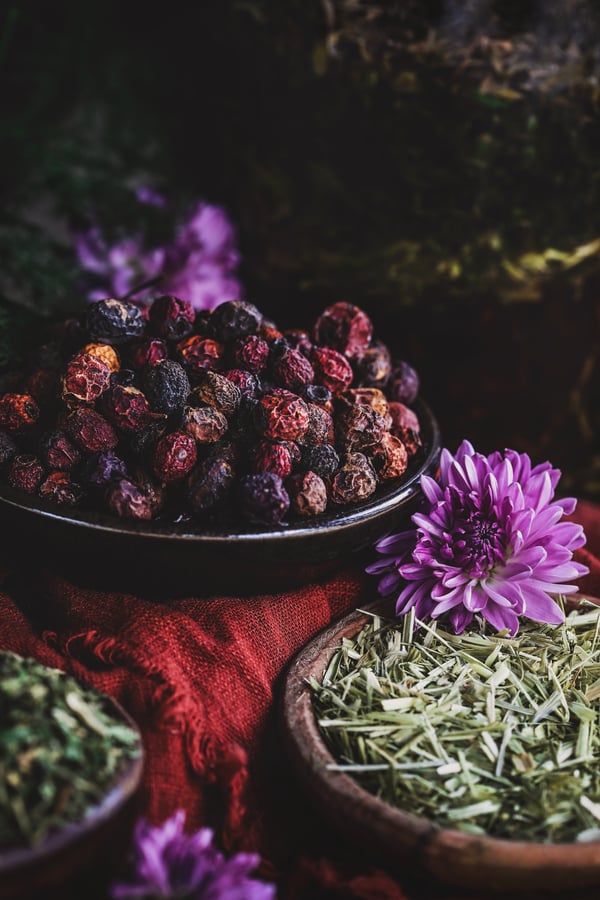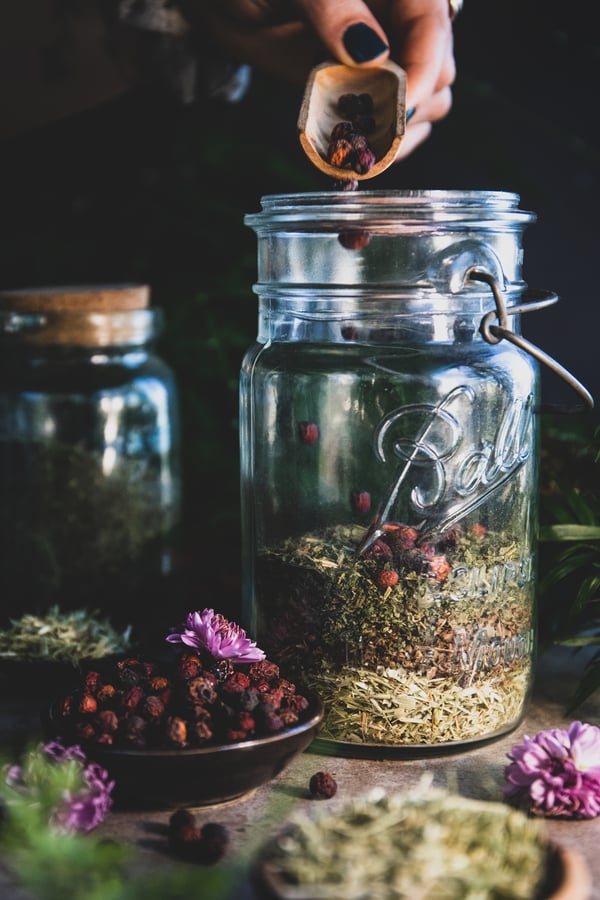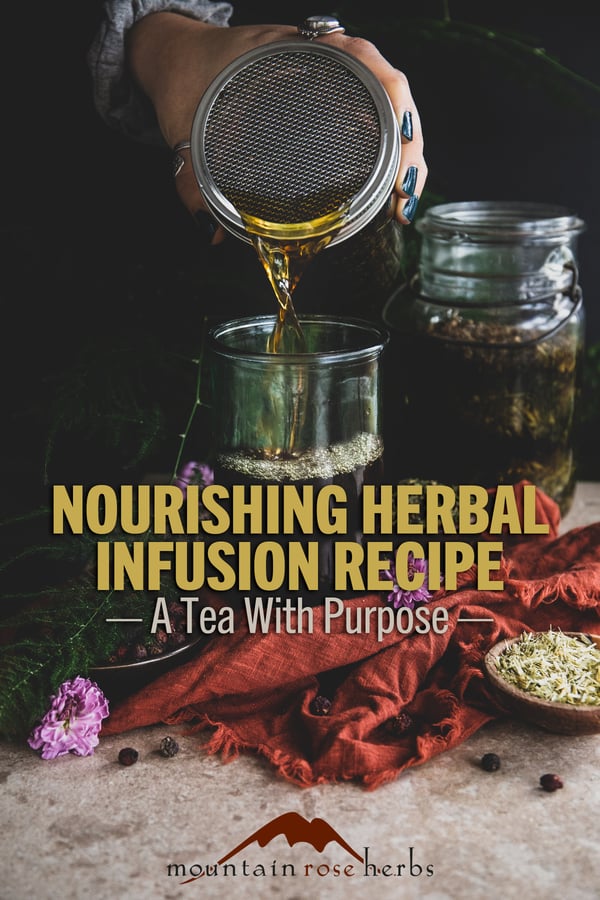Over the years, I’ve fallen in love with many herbs. Some come and go, others stick with me day after day once they’ve become part of my life. This nourishing infusion blend weaves together four of my long-term herbal allies. As a go-to for drinking daily, it is beloved by many in my extended community.
So, what’s the scoop on infusions? Why not just throw in a little tea bag and call it done?
When it comes to nutritive plants like these four treasured herbal allies, opting for the infusion method will impart your water-based brew with the full strength of the plant material. Certainly, you could steep these herbs in a tea bag for 10-15 minutes. However, you’ll receive exponentially more of the nutritive and tonifying benefits with the infusion method, which employs a hefty volume of herbs steeped for hours. This allows more of the minerals, chlorophyll, and other nutrients to be pulled into the solution.
Think of it this way: Infusions pull more of the power-packed punch out of your dried herbs. Brewing your herbs this way gives you a strong, nourishing brew—deep and rich in color, flavor, and constituents. Just the way you like it.
Meet the four beloved herbal allies in this infusion:
Oatstraw (Avena sativa): I love the mildly sweet flavor that oatstraw imparts to this brew. Made from the swaying straw of the oat plant, this herb is a calming and nourishing nervine. Think of oatstraw as a gentle friend to call on for a comforting hand to soothe the worried brow we all get from time to time. In the Middle Ages, Hildegard of Bingen—a visionary mystic, poet, musician, and herbalist—described oatstraw as one of her favorite “happiness” herbs.
Nettles (Urtica dioica): Rich in chlorophyll and minerals, nettle was my first herbal love. Many years ago, I discovered a lush patch of stinging nettles under a grandmother oak tree. I harvested the stinging nettles (with gloves!) to cook in soup and dry for infusions—and my body just kept calling for more and more. Beneath the sting is a nourishing tonic that, with regular use, supports general well-being and healthy energy levels. Let me put it this way: once nettles became part of my life, I let go of caffeinated black tea!
Tulsi (Ocimum tenuiflorum): Also known as holy basil, tulsi is considered sacred in many cultures. As an adaptogenic herb, tulsi supports the body in adapting to changes and stressors and strengthens the functioning of the body as a whole. Beloved as a supportive and relaxing nervine, the intoxicating scent of tulsi is divine! If you haven’t gotten to know holy basil yet, put this prized plant on your list. A vigorous garden herb, tulsi will delight your senses and your soul.
Hawthorn berries (Crataegus spp.): Hawthorn has been known and loved through the centuries for its affinity for the heart and circulatory system. Personally, I find hawthorn’s stabilizing influence on my heart to be both emotional and physical. But then, it's hard not to fall in love with an herb that’s so common and abundant, and also delicious and nutritious! In the fall, I treasure the days I head out to wildcraft hawthorn berries in a few choice spots. If you’re looking for a tree to plant, consider hawthorn—one day, you’ll harvest your own sweet, rich berries beneath the thorns.
5-Step Recipe — Nourishing Infusion Blend
Brew this mixture in a quart-size jar, which easily yields 2-3 cups of infusion. Note: Alternatively, you could make a “simple” infusion with 1 cup of any one of these herbs, following the instructions below.
Ingredients
- 1/2 cup dried organic oatstraw
- 1/4 cup dried organic nettle leaf
- 1/4 cup dried organic tulsi (holy basil)
- 5-10 dried organic hawthorn berries
- 4 cups water
Directions
- Place dried herbs in a glass quart-size jar.
- Boil water and pour it over herbs in the jar. I do this in my kitchen sink just to be on the safe side (once in a hundred times I’ve had a jar break—likely from a preexisting hairline crack).
- Steep for 4-10 hours. I prefer to prepare the infusion before bed and let it brew on the kitchen counter overnight.
- Strain out herbs. My tool of choice is a standard stainless steel mesh kitchen strainer. Give the herbs a squeeze to extract the potent liquid, and compost the plant material.
- Refrigerate. It usually keeps for several days in the fridge. Like food, when infusions spoil, they smell and taste sour. (Psst, you can always use soured infusion as a fertilizer for your plants!)
To Use
- Enjoy 1-2 cups a day, reheating in a pot on the stovetop.
- Optional: Sweeten to taste with honey and/or add milk to taste.
- In the heat of the summer, you might prefer to drink the infusion cold or pour over ice in a glass. Any way you like it—the important thing is to drink up!
When you’re thirsting for a nourishing cup of tea to support your body, consider making an infusion from any one of these herbs you feel drawn to. Or go all in with the full magic of all four. These timeless herbal allies, beloved over the ages, will enrich your life as they have mine.
WANT TO LEARN MORE about the wise woman tradition of herbalism?
Visit CorinnaWood.com
You may also be interested in:
- Herbal Tea Blend for Meditation
- 3 Magic Moon Milk Recipes for Restful Sleep
- Calming Marshmallow Rose Tea Blend













